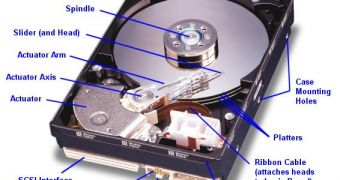The fastest enterprise hard disks spin at 15,000 RPM, and can achieve sequential media transfer speeds of up to and beyond 110 MB/s.
Modern hard drives use the spinning motion of a disk to move magnetic regions past a component that can read and change the data encoded on these regions. They record data by magnetizing a magnetic material in a pattern that represents the data. They read the data back by detecting the magnetization of the material.
Now, a team of researchers, composed of Guido Meier and colleagues at the University of Hamburg in Germany, has made an experimental breakthrough that could greatly increase the capacity and speed of hard drives.
They used nanosecond pulses of electric current to push magnetic regions along a wire at a speed of 110 meters per second. That's around 100 times faster than the fastest commercially available HDD on the market. "If you want to make a hard drive, operating speed is an important factor," says Meier. "The idea is also to get rid of the mechanical parts, so there's much less wear and tear, and devices can become more robust."
Previous attempts to create magnetic domains - moved along the wire by pulses of polarized current and read by fixed sensors within the silicon itself - have disappointed, producing speeds of up to a thousand times slower than predicted, thus impractical for storage applications. "Our results showed the movement of domains cannot be predicted with certainty as they get stuck on imperfections in the crystal," says Meier. "We believe this is why previous attempts were relatively slow as they used longer electric current pulses - up to microseconds long - increasing their chances of getting stuck."
The new experiment used powerful magnetic fields that were switched on and off to rapidly create magnetic domains in a wire less than a micron wide made of permalloy - a magnetic material made of iron and nickel that is often found in disk drives. As the regions contain numerous magnetized atoms aligned in the same direction and separated by domain walls, they can then be moved using much shorter nanoscale pulses. To read the data, the researchers used a powerful x-ray microscope, capable of resolving features as small as 15 nanometres.
Future hard drives could store data by designating a domain wall to be a binary one, while its absence could be interpreted as a binary zero.

 14 DAY TRIAL //
14 DAY TRIAL //